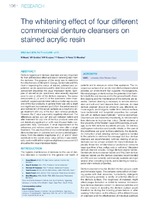The whitening effect of four different commercial denture cleansers on stained acrylic resin
| dc.contributor.author | Maart, Ronel Deidre | |
| dc.contributor.author | Kruijsse, H. | |
| dc.contributor.author | Osman, Yusuf Ismail | |
| dc.contributor.author | Moodley, Desi | |
| dc.contributor.author | Patel, Naren | |
| dc.contributor.author | Grobler, Sias Renier | |
| dc.date.accessioned | 2016-09-12T08:50:19Z | |
| dc.date.available | 2016-09-12T08:50:19Z | |
| dc.date.issued | 2016 | |
| dc.identifier.citation | Maart, R. et al. (206). The whitening effect of four different commercial denture cleansers on stained acrylic resin. South African Dental Journal, 71(3): 106 - 111 | en_US |
| dc.identifier.issn | 1029-4864 | |
| dc.identifier.uri | http://hdl.handle.net/10566/2408 | |
| dc.identifier.uri | http://ref.scielo.org/9pjs6b | |
| dc.description.abstract | Denture hygiene and denture cleansers are very important for their antimicrobial effect and also in removing stain from the dentures. The purpose of this study was to determine the effectiveness of Steradent, Corega, Dentalmate and Fitty Dent in improving the colour of stained, polished-and unpolished, acrylic specimens and to determine which colour component should be the visual impression factor. Samples of stained acrylic specimens were severally exposed once to one or other of the denture cleansers. The colour components (L*, a* and b*) of the specimens were measured with a spectrophotometer before and after exposure to one of the four products. In general there was only a slight non-significant improvement (p>0.05) in the yellowness (a*) and redness (b*) of the acrylic samples as a result of a single treatment with any of the four stain removal products. However, the L* value was mainly negatively influenced. The differences (ΔE*ab; ΔL*; Δa* and Δb*) between before and after treatment for any one of the four products were also not statistically significant on a 5% level (Kruskal Wallis nonparametric test). Conclusion: A small improvement of the yellowness and redness could be seen even after a single treatment. This was found for all four commercially available denture cleansers on polished and on non-polished specimens. From the relative magnitudes of L*, a* and b* which contribute to the overall colour value (ΔE*ab) it was statistically confirmed that the brightness/lightness component (L*) should be the visual impression factor. | en_US |
| dc.language.iso | en | en_US |
| dc.publisher | South African Dental Journal | en_US |
| dc.rights | This file may be freely used for educational uses. No commercial reproduction or distribution of this file is permitted without written permission of the South African Dental Association (SADA). Note that the SADA retains all intellectual property rights in the article. | |
| dc.rights.uri | http://creativecommons.org/licenses/by/4.0/deed.en | |
| dc.subject | Denture cleanser | en_US |
| dc.subject | Dental acrylic | en_US |
| dc.subject | Dentures | |
| dc.title | The whitening effect of four different commercial denture cleansers on stained acrylic resin | en_US |
| dc.type | Article | en_US |
| dc.privacy.showsubmitter | false | |
| dc.status.ispeerreviewed | true | |
| dc.description.accreditation | Department of HE and Training approved list | en_US |
Files in this item
This item appears in the following Collection(s)
Except where otherwise noted, this item's license is described as This file may be freely used for educational uses. No commercial reproduction or distribution of this file is permitted without written permission of the South African Dental Association (SADA). Note that the SADA retains all intellectual property rights in the article.


